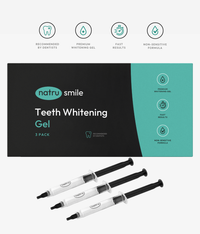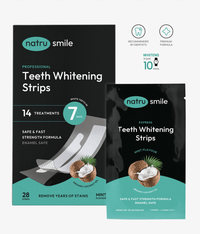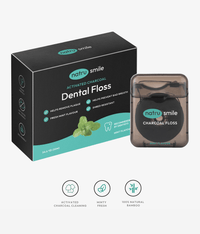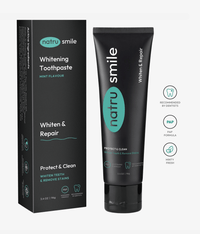
All products are certified by dental expert Dr. Greg Grillo
Do you want to improve your smile without having to wear those bulky metal braces? Then invisible braces may be just what you need.
Although braces are usually associated with kids, about 20% of adults actually have them today. With invisible braces, adults can avoid the discomfort of metal braces.
Invisible braces provide plenty of benefits for people who want straight teeth but don't want their orthodontic work to be obvious. They are also removable, making it easier to brush your teeth, eat, and go about your day-to-day activities.
But before proceeding, it might be worth knowing how much invisible braces cost, as well as if they're worth the investment.
Here is everything you need to know about the cost for invisible braces, along with the factors that affect their price, alternatives, and the most frequently asked questions about this growingly popular dental treatment.
How Do Invisible Braces Work?
Invisible braces, such as Clear Invisalign Aligners, among the most popular, are a modern alternative to traditional metal braces. They use clear aligners that fit snugly over your teeth and adjust them into the proper position over time.
Invisible aligners have advantages over metal braces, as they are transparent and barely noticeable, as well as being less irritating to the mouth.
While invisible braces may seem like a magical solution to crooked teeth, there is actually a complex process behind how they work. The most defining part of the process is getting an accurate impression of your mouth structure and smile goals from your dentist.
The process involves wearing a series of custom-made, transparent aligners that must be changed every 7-10 days as your teeth begin to adjust. Each new aligner is tailored specifically for you and will help bring out your best smile.
Invisible braces work by putting gentle pressure on each tooth in order to move it into its proper position over time. As you wear each set of aligners for two weeks, they will gradually shift your teeth until they reach their correct alignment. The results of invisible braces can be seen in as little as 6 weeks, with the treatment taking up around 12-18 months.
How Much Do Invisible Braces Cost In 2023?
The cost of invisible braces has gone down in recent years, making them more accessible for people with all kinds of budgets. But how much are you expected to pay for invisible braces today?
Generally speaking, braces cost around $3,000-$8,000. Although traditional metal braces are less expensive than Invisalign, clear braces can be more affordable. The following are some of the most popular invisible braces and their prices:
- Invisalign - ranges from $3,000-$8,000 for 12-18 months
- Candid - ranges from $3,000-$7,000 for 6 months
- SmileDirectClub - $2,050 for 4-6 months
- Byte - $1,999-$2399 for 4-6 months
With the Clear Braces vs Invisalign Treatment comparison, clear braces are affixed with brackets and wires that cannot be removed without the help of an orthodontist. However, Clear Invisalign Aligners can be taken off when desired.
If you only need minor corrections, such as closing small gaps or straightening slightly crooked teeth, then your costs will likely be on the lower end of the spectrum.
On the other hand, if you require more complex treatments, such as major tooth movement or correction of a severe overbite, then the costs can be higher.
You should also factor in additional costs associated with your treatment plan. This may include retainers for maintaining your new smile and follow-up visits with your orthodontist for adjustments and checkups. In some cases, you may even need scans or dental impressions to get started on your plan.
Fortunately, many orthodontists offer financing plans that make it easier to spread out payments over time, making invisible braces a feasible option.
What Factors Affect The Cost Of Invisible Braces
The cost for invisible braces can be an intimidating prospect for those looking to improve their smile. But, with a better understanding of the factors that affect the price, it is easier to make an informed decision about which type of orthodontic treatment is best for you.
Type
The cost can vary greatly depending on several factors, one of which is the type of invisible brace used. The most common type of invisible brace is known as clear aligners. These types of braces use a series of custom-made plastic trays that fit over your teeth and slowly shift them into the desired position.
Clear aligners are removable, so they make it easy to maintain proper oral hygiene during treatment, and they also tend to be more comfortable than traditional metal braces. However, they are usually more expensive than traditional braces because each tray needs to be individually created by a dental lab.
Another type of invisible brace is known as lingual braces. These types of braces are placed behind the teeth so that they are hidden from view and virtually undetectable when you smile or talk. Lingual braces tend to be a more complex procedure and require specialized training for the orthodontist, making them more expensive than clear aligners.
Additionally, since these types of braces need to fit precisely around your teeth, there can sometimes be extra costs associated with adjustments or additional fittings during treatment.
Severity Of Misalignment
The severity of your teeth's misalignment determines how much time and effort needs to be invested in straightening your teeth, which directly affects the total cost.
Minor misalignment means that only a few teeth need slight adjustments in order for them to align properly with each other. This type of correction usually requires minimal intervention from an orthodontist. As a result, the cost of invisible braces for minor misalignment cases is generally lower than for more severe cases.
Severe misalignment means that multiple teeth are out of place and require more significant corrections in order to achieve proper alignment. This type of case typically requires more complex treatment with longer treatment times and additional components such as expanders or headgear.
Geographic Location
While the technology behind this form of teeth alignment is the same worldwide, location has a large impact on how much patients pay for their invisible braces.
The cost of invisible braces can vary from one area to the next due to a number of factors, including local taxes, insurance coverage, and the availability of providers.
In general, prices tend to be higher in large metropolitan areas because of competition among orthodontics patients. Prices may also be higher if you live in an area with fewer options for treatment or where there is a shortage of qualified orthodontists who offer the service.
Additionally, some regions may require that you pay more out-of-pocket costs than others due to differences in health insurance coverage and other factors. In fact, 76.5 million adults lack dental insurance, with some having no coverage at all.
Regardless of where you live or the complexity of your treatment, it is advised to research and compare prices before deciding on invisible braces. A bit of research can save you money in the long run and help you find the best price for your treatment.
How To Save For Invisible Braces
Invisible braces can be expensive, so it’s important to plan ahead and save up for them if you want this modern orthodontic treatment. Here are some tips on how to save money for invisible braces.
- Start early – The earlier you start saving for your invisible braces, the better off you will be when it comes time to pay for them. Set aside a small amount each month from your paycheck or other income sources in order to build up a fund over time.
- Utilize tax breaks – Many employers offer flexible spending accounts that allow you to set aside pre-tax money for medical expenses. You can use this account to save up for invisible braces, as well as other orthodontic treatments like traditional metal braces and retainers.
- Consider financing options – If you don’t have enough money saved up for the full cost of your invisible braces, consider financing options, such as CareCredit or OrthoFi, to help spread out payments over a longer period of time and make them more manageable.
- Shop around – Don’t just go to the first orthodontist you find. Shop around and compare prices, as well as any financing options that may be available, in order to get the best deal on your invisible braces.
- Talk to your insurance provider – Many insurance providers offer discounts or coverage for certain orthodontic treatments, such as invisible braces. Check with your provider to see what kind of coverage they offer and if it could help you save money on your treatment costs.
By following these tips, you can start saving up now so that when it comes time for your invisible braces treatment, you’ll be able to pay for it without breaking the bank.
Payment Options For Invisible Braces
If you are looking to improve your smile with invisible braces, the cost will likely be a determining factor. The good news is that several payment plans are available to make teeth correction more affordable.
Payment Plan
To avoid outrageous interest rates, it is advisable to form a payment plan with the orthodontist. The majority of payment plans have options for 3, 6, 12, or 24 months.
This option is great as most people don't have thousands of dollars on hand. Aside from emergencies, families often need money in other areas as well, so putting all of it towards one expense can be difficult.
Insurance Plan
Insurance plans typically cover some or all of the costs associated with orthodontic treatments, such as invisible braces. Even though there may still be some costs that need to be covered by the patient, this can be much less than if they had to pay for the entire treatment themselves.
In addition, many insurance plans have a “lifetime maximum” amount that they will cover for orthodontic treatments. This makes it even more affordable to get invisible braces and makes them an attractive option compared to traditional metal braces.
Credit Card
Credit cards are a great payment option for invisible braces because they provide convenience and flexibility. Credit cards allow you to pay for your treatment over time, which can be especially helpful if the cost of your invisible braces is high.
Additionally, credit card payments are secure and easy to track in case of any issues with billing or disputes. Using a credit card also offers benefits like earning rewards points that can be used towards future purchases or travel expenses, building up a good credit score with responsible use, and access to additional perks.
Personal Loan
With personal loans, you can borrow a lump sum of money at once and then make monthly payments until it’s paid back in full. This allows you to spread out the costs of your invisible braces over a period of time while still making progress toward achieving that perfect smile.
Plus, since many lenders offer competitive rates and repayment terms, it may be possible to find a loan that fits your budget. Another advantage to using a personal loan is the ability to take advantage of any discounts or promotions offered by your orthodontist. This could be anything from a percentage of the total cost to free retainers when you’re finished with treatment.
Cost-Effective Invisible Braces Alternatives
As more people look to achieve a perfect smile, clear braces have become an increasingly popular orthodontic option. While these types of braces may be the most aesthetically pleasing, they can also come with a high price tag. Some teeth hurt with braces as well, so dentists try to find alternatives that are comfortable for their patients.
Fortunately, there are cost-effective alternatives available to straighten teeth without braces and without breaking the bank.
- At-home aligners - This is usually successful in obtaining the desired straight smile without having to go to the dentist. In most cases, however, most companies that offer home aligners have a refinement process to ensure the completion of the procedure. For more extreme misalignments, it is best to consult an orthodontic professional.
- Metal braces - If the cost is a factor in your decision-making process, metal braces may be your better option due to their lower price tag and broader coverage from insurance providers.
- Retainers - This cost-effective removable dental appliance is custom-made and fits over the top and bottom of your teeth, helping to correct alignment issues without the need for wires, brackets, or other uncomfortable fixtures associated with traditional orthodontic treatments.
- Dental headgear - While not the most comfortable, they're more affordable than clear braces and can correct extreme overbites effectively. They also don't need to be worn all day.
Depending on your condition and how severe your tooth alignment problems are, braces may not be necessary depending on your condition. Check with your dentist to find out if there are any more affordable options available.
Does Insurance Cover The Cost?
Many dental insurance plans cover the cost of invisible braces. It's likely that your plan will pay for a portion of the cost or a set dollar amount. However, there is usually a limit on how much insurance can contribute to orthodontic work.
To find out more details, contact your employer’s benefits manager and insurance provider, or review your benefits package for information regarding orthodontic treatment. Medical insurance may also cover orthodontic treatments if they are deemed necessary due to facial deformities, impacted teeth, and severe bite issues.
To assist you in making an informed choice, we’ve listed the more frequently asked questions about invisible braces listed below.
Are Invisible Braces Cheaper Than Regular Braces?
Traditional metal braces are generally less expensive than invisible braces and offer more payment options, as well as a wider range of dental insurance coverage. People who are trying to save money may also look into at-home clear aligners for a less costly way to straighten their teeth that doesn't involve major dental work.
How Long Do Invisible Braces Last?
Invisible braces treatments can vary greatly in length, depending on the specifics of each individual case. Orthodontists typically suggest that treatment could take anywhere from 6-12 months or longer since every patient has a unique tooth alignment issue.
Are Invisible Braces Worth It?
Invisible braces offer the same outcome as traditional metal ones but without any undesirable aesthetic appearances, so it’s an excellent option if you’re not a fan of regular color braces. The aligners are much more subtle than metal brackets and can be completed in about a year.
There aren't any restrictions on what you can eat or drink either. Moreover, unlike cleaning teeth with traditional braces, it's simpler to clean your teeth with invisible ones since you remove the trays when brushing and flossing.
Do Invisible Braces Cost More?
The cost for invisible braces is generally higher than traditional metal braces because of the materials and construction involved. The brackets for clear braces may also be slightly larger than those for metal braces, adding to the total cost.
Are Invisible Braces Painful?
While clear braces are excellent for straightening teeth, they can be somewhat uncomfortable at times.
Generally, the pain is less than with traditional metal braces and varies from person to person. While many people report having some soreness or tenderness during the first days of wearing their trays, the majority report experiencing significantly less pain than with metal braces.
What's The Cheapest Way To Straighten Teeth?
Traditional metal braces are widely used and provide an economical solution for straightening teeth. There is a higher price tag associated with clear aligners, and they are not recommended for patients with severe misalignment issues.
Can You Kiss Someone With Invisalign?
You definitely can kiss while wearing Invisalign, and with the added bonus that most people won't even notice your aligners since they're virtually invisible.
You don't have to worry about any awkwardness, either. The smooth design and snug fit of Invisalign braces mean they stay put throughout your smooch session and won't interfere in any way.
How Do You Brush Your Teeth With Invisalign?
Unlike brushing your teeth with braces, no special brushing methods are necessary with Invisalign since it can be removed. Take your aligners out before brushing and flossing your teeth as you normally would.
Do Lips Get Smaller After Braces?
It is unlikely that your lips will be affected by the removal of braces, though they may appear thinner. Depending on what type of braces you had, the change could be more or less noticeable. This means that there is no need to worry about any drastic alteration in your lip size.
What Are The Disadvantages Of Invisalign?
One of the downsides of Invisalign is that you need to wear the clear aligners for 20-22 hours a day, only taking them out to eat and brush your teeth. Additionally, brushing is recommended after eating in order to prevent staining of the aligners.
Moreover, Invisalign may also not be as effective for more complicated dental issues and is typically recommended for patients who only require certain kinds of movement with their teeth.
Is Invisalign More Painful Than Braces?
People often find that Invisalign is much less painful than metal braces when it comes to straightening their teeth.
Invisalign works by using gentle pressure to gradually move teeth into alignment, which is less intense than what metal brackets and wires cause. Ultimately, people can expect a more comfortable experience with Invisalign.
Final Thoughts
Invisible braces are an effective and increasingly popular way to straighten your teeth without the need for metal brackets and wires. They provide similar results as traditional braces but with greater convenience and discretion.
The cost for invisible braces is generally more expensive than traditional braces, but many people find that the additional cost is worth it when considering all the benefits they offer. Ultimately, the choice between invisible or traditional braces comes down to personal preference and budget considerations.











